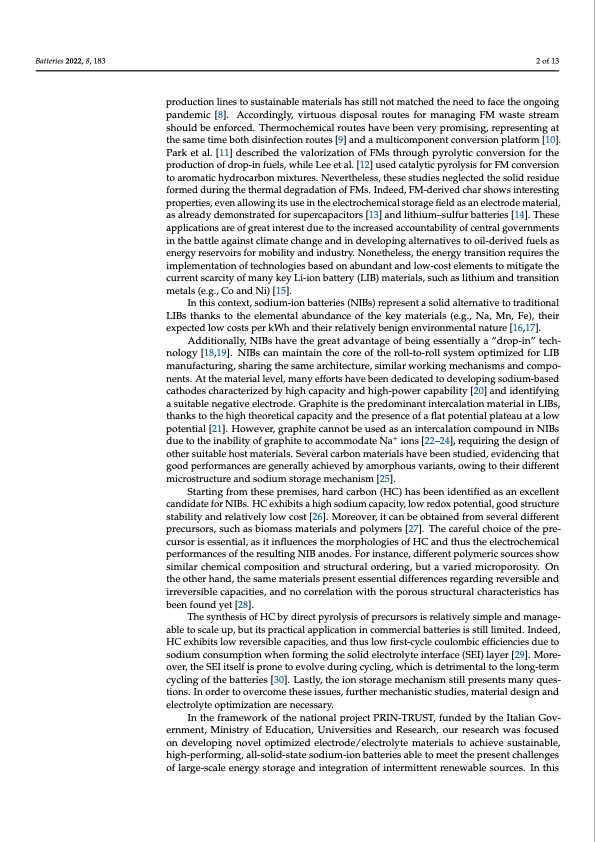
PDF Publication Title:
Text from PDF Page: 002
Batteries 2022, 8, 183 2 of 13 production lines to sustainable materials has still not matched the need to face the ongoing pandemic [8]. Accordingly, virtuous disposal routes for managing FM waste stream should be enforced. Thermochemical routes have been very promising, representing at the same time both disinfection routes [9] and a multicomponent conversion platform [10]. Park et al. [11] described the valorization of FMs through pyrolytic conversion for the production of drop-in fuels, while Lee et al. [12] used catalytic pyrolysis for FM conversion to aromatic hydrocarbon mixtures. Nevertheless, these studies neglected the solid residue formed during the thermal degradation of FMs. Indeed, FM-derived char shows interesting properties, even allowing its use in the electrochemical storage field as an electrode material, as already demonstrated for supercapacitors [13] and lithium–sulfur batteries [14]. These applications are of great interest due to the increased accountability of central governments in the battle against climate change and in developing alternatives to oil-derived fuels as energy reservoirs for mobility and industry. Nonetheless, the energy transition requires the implementation of technologies based on abundant and low-cost elements to mitigate the current scarcity of many key Li-ion battery (LIB) materials, such as lithium and transition metals (e.g., Co and Ni) [15]. In this context, sodium-ion batteries (NIBs) represent a solid alternative to traditional LIBs thanks to the elemental abundance of the key materials (e.g., Na, Mn, Fe), their expected low costs per kWh and their relatively benign environmental nature [16,17]. Additionally, NIBs have the great advantage of being essentially a “drop-in” tech- nology [18,19]. NIBs can maintain the core of the roll-to-roll system optimized for LIB manufacturing, sharing the same architecture, similar working mechanisms and compo- nents. At the material level, many efforts have been dedicated to developing sodium-based cathodes characterized by high capacity and high-power capability [20] and identifying a suitable negative electrode. Graphite is the predominant intercalation material in LIBs, thanks to the high theoretical capacity and the presence of a flat potential plateau at a low potential [21]. However, graphite cannot be used as an intercalation compound in NIBs due to the inability of graphite to accommodate Na+ ions [22–24], requiring the design of other suitable host materials. Several carbon materials have been studied, evidencing that good performances are generally achieved by amorphous variants, owing to their different microstructure and sodium storage mechanism [25]. Starting from these premises, hard carbon (HC) has been identified as an excellent candidate for NIBs. HC exhibits a high sodium capacity, low redox potential, good structure stability and relatively low cost [26]. Moreover, it can be obtained from several different precursors, such as biomass materials and polymers [27]. The careful choice of the pre- cursor is essential, as it influences the morphologies of HC and thus the electrochemical performances of the resulting NIB anodes. For instance, different polymeric sources show similar chemical composition and structural ordering, but a varied microporosity. On the other hand, the same materials present essential differences regarding reversible and irreversible capacities, and no correlation with the porous structural characteristics has been found yet [28]. The synthesis of HC by direct pyrolysis of precursors is relatively simple and manage- able to scale up, but its practical application in commercial batteries is still limited. Indeed, HC exhibits low reversible capacities, and thus low first-cycle coulombic efficiencies due to sodium consumption when forming the solid electrolyte interface (SEI) layer [29]. More- over, the SEI itself is prone to evolve during cycling, which is detrimental to the long-term cycling of the batteries [30]. Lastly, the ion storage mechanism still presents many ques- tions. In order to overcome these issues, further mechanistic studies, material design and electrolyte optimization are necessary. In the framework of the national project PRIN-TRUST, funded by the Italian Gov- ernment, Ministry of Education, Universities and Research, our research was focused on developing novel optimized electrode/electrolyte materials to achieve sustainable, high-performing, all-solid-state sodium-ion batteries able to meet the present challenges of large-scale energy storage and integration of intermittent renewable sources. In thisPDF Image | From Wastes to Anode Materials for Na-Ion Batteries

PDF Search Title:
From Wastes to Anode Materials for Na-Ion BatteriesOriginal File Name Searched:
batteries-08-00183.pdfDIY PDF Search: Google It | Yahoo | Bing
Salgenx Redox Flow Battery Technology: Salt water flow battery technology with low cost and great energy density that can be used for power storage and thermal storage. Let us de-risk your production using our license. Our aqueous flow battery is less cost than Tesla Megapack and available faster. Redox flow battery. No membrane needed like with Vanadium, or Bromine. Salgenx flow battery
| CONTACT TEL: 608-238-6001 Email: greg@salgenx.com | RSS | AMP |